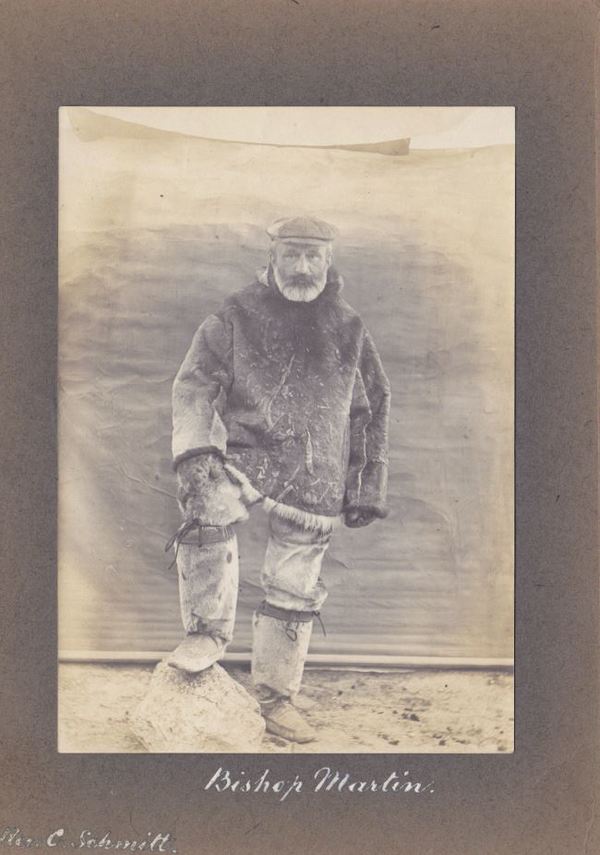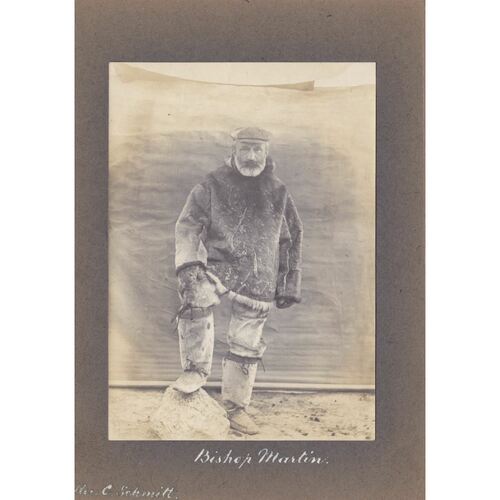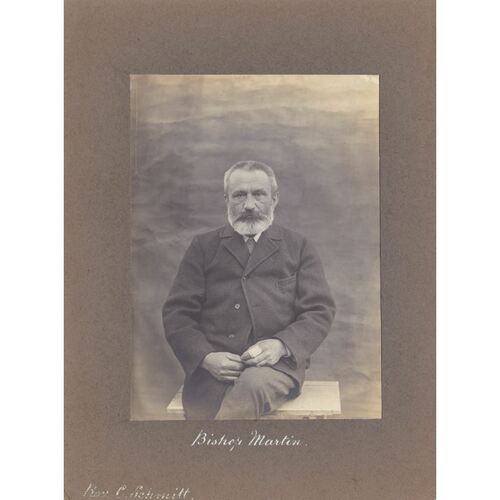
Source: Link
MARTIN, CARL ALBERT, educator, Moravian missionary, bishop, and author; b. 17 Oct. 1861 in Gnadenfrei (Piława, Poland), son of Franz Theodor Martin and Bertha Baer; m. 3 June 1888 Anna Lydia Oelmann (1864–1939) in Kleinwelka, Germany, and they had eight sons and one daughter; d. 22 Oct. 1934 in Herrnhut, Germany.
Albert Martin, as he was known, was born into a Moravian family in what was then Prussia. His father died when the boy was young, leaving the family in financial difficulties. But he was able to attend the church’s school in Niesky (Germany) on a scholarship and then the theological seminary in Gnadenfeld (Gościęcin, Poland) between 1881 and 1884. He became a teacher at the Moravian boys’ school in Kleinwelka, a position he relinquished when he was called to missionary service in Labrador. Though Martin had long been interested in the church’s overseas work and had been especially thrilled by the story of its early days in Greenland, the call apparently came as a surprise. At Easter 1888 he was ordained a deacon, and in June he married Anna Lydia Oelmann, a qualified teacher and the daughter of Moravian missionaries in South Africa. The newly wed couple departed for Labrador shortly after.
In Nain, Martin became an assistant to Johann Heinrich Theodor Bourquin*, superintendent of the Labrador mission; he replaced the older man temporarily in 1889 and took over his role permanently in August the following year. Like Bourquin, Martin belonged to a new class of academically trained Moravian leaders. Already conversant in the Greenlandic language because of private instruction he had received in Germany from a former missionary, which included tuition in phonetics, he mastered the Labrador dialect of Inuktitut more quickly and thoroughly than other newcomers.
His educational background prompted him to reorganize the Inuktitut school curriculum in Labrador so as to give greater emphasis to learning strategies reflective of the local environment. Rather than a simple problem in addition, he proposed an example from everyday life: “Into the bay there come 3 sleds. The first is pulled by 4, the second by 5, the third by 6 dogs. How many dogs are coming?” “It is my experience,” Martin wrote, “that our Eskimo children apply themselves more industriously to such problems and thus count faster than if one operates merely with numbers.” He also established formal training courses at Nain for aboriginal teachers.
While on furlough in Germany in 1899, Martin was a delegate to the general synod of the Moravian church, held in Herrnhut. The synod proposed several measures to promote the independence and self-sufficiency of mission churches, including the consecration of bishops in the larger fields. Martin, who had been made a presbyter on 15 January that year, became a bishop on 22 October, together with missionaries to Surinam and South Africa. On his return to Labrador in August 1900, he resumed his administrative duties. He would take another European furlough in 1913–14.
Martin’s superintendency also saw the introduction of a new form of church governance in Labrador with the establishment of councils or boards, known in Moravian tradition as Gemeinrat and locally as angajoKauKatigêt; they consisted of native helpers (kivgat) chosen by the missionaries, and elected congregational representatives. These elderships were able to build upon the men’s meetings that had been implemented in the Labrador mission in 1865. Setting up the councils was one of the suggestions for greater aboriginal involvement in church and community affairs that had been made by the general synod of 1899, which also encouraged the regular collection of fees to increase local identification with and a sense of responsibility for mission churches.
Martin contributed to the growth of literacy in Labrador by revising several Inuktitut translations, including the biblical books of Isaiah and the Pentateuch, the Passion liturgies, and the Moravian hymn-book that has continued to be used there. To provide opportunities for communication in the local dialect, in 1902 he started a bimonthly newsletter, Aglait illũnainôrtut (Writings for all), which eventually became an illustrated magazine. It was printed on a press Martin established in Nain that also produced smaller items, such as catechetical literature and gospel songs. As well, he published children’s stories and an Inuktitut reader. A keen, if somewhat paternalistic, observer of Labrador aboriginal traditions, Martin wrote two small books that reflect his intimate knowledge of Inuit culture: Das Leben des Labrador-Eskimo (Life of the Labrador Eskimo) (Herrnhut, 1903) and Die Bibel und unsere Eskimo (The Bible and our Eskimo) (Herrnhut, 1928).
A Prussian consulate had been set up at Nain in 1879 to assist the German-born missionaries in Labrador and their families, and like his predecessor, Bourquin, Martin served in this capacity, holding the post from 1892 until the outbreak of World War I. Moravians had meticulously recorded weather in the region from the 18th century on, first for the Royal Society of London and then, in the 19th century, for the Deutsche Seewarte, the German marine observatory in Hamburg, which collected data worldwide. In 1913 the Prussian government awarded Martin the Order of the Red Eagle, fourth class, for his work as a meteorologist.
During the war he turned over his position as superintendent to fellow missionary Walter Whatley Perrett, and he and his wife moved to the northern settlement of Hebron. There the Martins ministered to the many members of their congregation who were victims of the devastating Spanish influenza pandemic of 1918–19. They retired from active service in 1922 and later lived in Kleinwelka and Herrnhut. When Carl Albert Martin died in Herrnhut in 1934 at the age of 73, a Moravian church publication lamented the passing of “a true and great missionary.”
Carl Albert Martin’s reader appeared as Unipkautsit attornartut ajokertûtsemut kaujijaksaujune sunatuinarne: illiniarvingnullo kittorngarênullo illingajut [Inuktitut reader for school and home] (Herrnhut, Germany, 1899); his revised translation, with W. W. Perrett, of the book of Isaiah was published as Nellautaijub Jesaiasib aglangit (Herrnhut, 1903); and his stories for children were printed in the magazine Aus Nord und Süd: Missionsblatt der Brüdergemeine für die Jugend [From north and south: Moravian mission magazine for the youth] (Hernnhut). The Inuktitut lectures for his teacher-training courses are held by the Them Days Arch., Happy Valley-Goose Bay, Nfld.
Moravian Arch. (Bethlehem, Pa), Records of the Moravian Mission in Labrador [1764–1944] (mfm. at the Memorial Univ. of Nfld, Queen Elizabeth II Library, Centre for Nfld Studies, St John’s). Unitätsarchiv/Moravian Arch. (Herrnhut), Moravian Mission records relating to Labrador, 1750–1908 (mfm. at the Centre for Nfld Studies). “Carl Albert Martin,” Moravian Missions (London), 33, no.2 (February 1935): 12. Missions-Ordnung der Labrador-Missionsprovinz/Rules and regulations of the Labrador Mission Province (Herrnhut, 1912). Hans Rollmann, “The origin of fog: a Labrador Inuit folk tale,” Newfoundland and Labrador Studies (St John’s), 23 (2008): 79–84: https://journals.lib.unb.ca/index.php/nflds/article/view/10179/10506.
Cite This Article
Hans J. Rollmann, “MARTIN, CARL ALBERT,” in Dictionary of Canadian Biography, vol. 16, University of Toronto/Université Laval, 2003–, accessed December 16, 2025, https://www.biographi.ca/en/bio/martin_carl_albert_16E.html.
The citation above shows the format for footnotes and endnotes according to the Chicago manual of style (16th edition). Information to be used in other citation formats:
| Permalink: | https://www.biographi.ca/en/bio/martin_carl_albert_16E.html |
| Author of Article: | Hans J. Rollmann |
| Title of Article: | MARTIN, CARL ALBERT |
| Publication Name: | Dictionary of Canadian Biography, vol. 16 |
| Publisher: | University of Toronto/Université Laval |
| Year of publication: | 2016 |
| Year of revision: | 2016 |
| Access Date: | December 16, 2025 |




